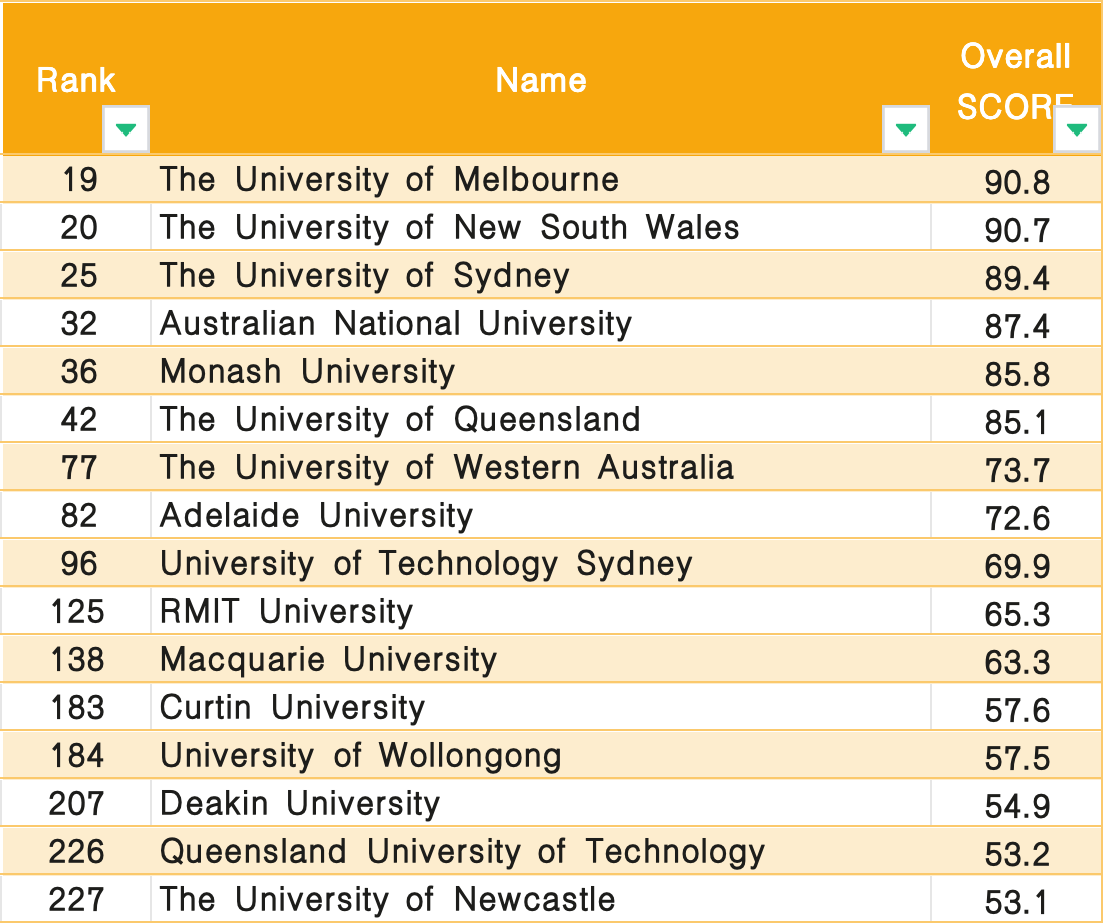2026 QS rankings: The rise and fall of Australian universities
The 2026 QS World University Rankings have been released, drawing significant attention to the performance of Australian universities in an increasingly competitive global higher education landscape. This year’s results reveal a mixed picture — there are definite highlights, but also emerging challenges.
1. Overall performance of Australian universities in the 2026 QS rankings
Australia has 25 universities ranked in the global top 500, with 9 institutions placed in the top 100, maintaining the same number as last year. This reflects the stability and overall strength of Australia’s higher education system.
The University of Melbourne remains the top-ranked university in Australia, although it has dropped from 13th to 19th globally. The University of New South Wales (UNSW) made a notable leap, moving from 19th to 20th and overtaking the University of Sydney, which slipped to 25th this year. The Australian National University (ANU) now sits at 32nd globally, while Monash University improved from 42nd to 36th, showing consistent growth within the top 100. The University of Queensland (UQ) is now ranked 42nd, the University of Western Australia (UWA) holds the 77th spot, and the newly merged Adelaide University (combining the former University of Adelaide and the University of South Australia) made its debut at 82nd. The University of Technology Sydney (UTS) remains in the top 100, currently ranked 96th, though it has dropped eight places from last year.
Other strong performers include RMIT University (125th) and Macquarie University (138th), both securing places within the global top 200.
2. Key strengths of Australian universities
Internationalisation
Australian universities continue to excel in internationalisation. Twelve universities achieved full scores for international faculty ratio, and five achieved full marks for international student ratio. The University of Sydney, for example, has an international student population of 43%, with students from 134 countries, creating a rich, diverse learning environment. This international diversity significantly enhances students’ cross-cultural communication skills and builds a truly global alumni network. The newly introduced “International Student Diversity” metric is not yet weighted but is expected to become a key driver in future rankings.
Graduate employability
Australian universities remain highly competitive in graduate outcomes. UNSW engineering and IT graduates, for instance, can earn upwards of AUD 85,000 as a starting salary, and UTS boasts graduate employment rates over 90% in IT and nursing. Employer reputation now accounts for 15% of the QS score, and Australian universities perform strongly in work-integrated learning. Institutions like Queensland University of Technology (QUT) have strong industry partnerships, and many undergraduate programs include built-in internships or industry projects, giving students practical, job-ready skills even before graduation.
Sustainability and Research collaboration
Australian universities also perform well in sustainability (5% weighting) and international research networks (5% weighting). Many universities are actively engaged in global research initiatives related to sustainable development, further cementing Australia’s academic influence on the world stage.
3. Emerging challenges
Reduced Emphasis on Academic Reputation
The academic reputation weighting in the QS rankings has been reduced from 40% to 30%, which has impacted some Australian universities that traditionally held strong positions in this area. This adjustment has slightly weakened their previous research-driven advantages, contributing to the shifts in the rankings.
Policy Changes and Regional Competition
From a policy perspective, tuition fees in Australia are expected to rise by 5-8%, which may increase financial pressure on international students. At the same time, potential tightening of migration pathways could influence students who are aiming to transition to permanent residency. Furthermore, regional competitors, especially within the Asia-Pacific, are rapidly improving their higher education offerings, increasing competition for international students.
4. What this means for international students
Choosing the right university
-
Research-Focused Pathway: For students aiming for research excellence, the University of Melbourne and ANU remain top choices, offering exceptional academic resources and reputations.
-
Employment-Focused Pathway: UNSW and UTS are particularly attractive for career-driven students. UNSW is highly regarded by employers, especially in engineering and IT, while UTS places strong emphasis on employability and practical skill development.
-
Migration-Focused Pathway: The newly formed Adelaide University benefits from South Australia’s relatively favourable state nomination policies, and UWA’s mining engineering program offers strong pathways for skilled migration applicants.
Rankings are not everything
Students should avoid focusing solely on rankings. For example, while the University of Sydney has slipped overall, its medicine and law programs remain among the world’s best. When selecting a university, students should align their choices with their professional goals, the specific strengths of each institution, local migration policies, and long-term career planning.
If you have any questions or would like professional assistance, please feel free to contact us at Riverwood Migration (Email: [email protected]). We are committed to providing transparent, expert migration services to help you achieve your dream of moving to Australia.






